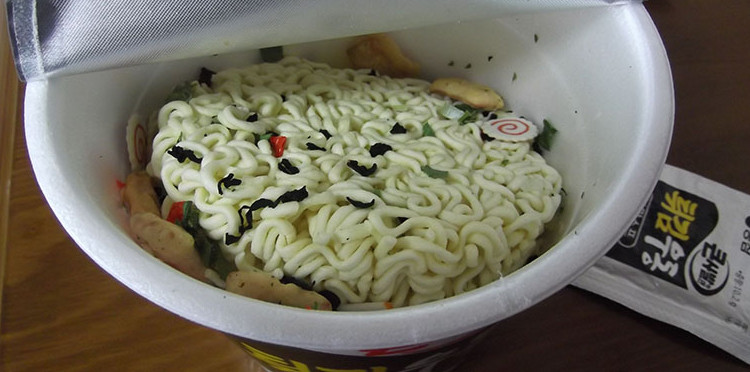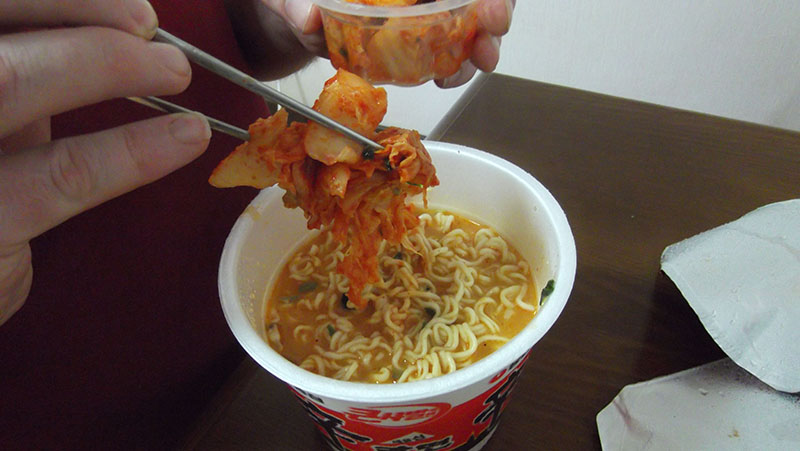Noodles of Doubt

They say travel changes you. I think it changes reality. Things we knew 100% for sure when kicking around Wisconsin aren't so fixed on this side of the world. It’s like a twisting kaleidoscope. One day something is Just The Truth, and the next it’s all Hell, I Don’t Know Which Way’s Up Anymore. You can call it whatever you like: a philosophical questioning of perceived reality, an exploration of cultural perspectives. I call it ramen noodles. Soggy, salted, cardboard strands of noodly badness. After leaving college for a life of reasonably well-compensated employment, I knew I'd never eat that stuff again.
Then we moved to South Korea. There’s an entire ramen noodle culture in this country. People hork it down right in the convenience store. Complimentary hot water and chopsticks are provided with purchase. Pass any CVS and you’ll see a clutch of people shoveling noodles into their mouth behind the plate glass window.
There are lots of reasons ramen is popular in Korea. It’s fast. It’s salty.* It’s cheap. Noodles in soup are a traditional concept. And, not incidentally, it’s freakishly delicious.
I don’t know what the difference is, but Korean ramen and US ramen are two entirely different branches on the noodle tree. Conceptually, it’s the same deal: immerse noodle brick in hot water, add spice packet, slurp. But aside from the appalling sodium content, there’s no comparing the taste.
I had to be bullied into trying Korean ramen. I was teaching my first summer camp, and the school cafeteria was closed. A fellow teacher refused to let me eat my brown-bagged lunch—actually took it out of my hands—and set me up with a ramen cup from his personal stash. He instructed me on the preparation (add hot water, wait four minutes). Then, perhaps fearing I’d mess it up, proceeded to make it for me.
First I scalded my mouth with the hot water. Then my lips burned from the spices. All that, and it was still delicious. This started me on the path to conversion. Nowadays, ramen is our favorite weekend lunch.
There are whole supermarket aisles devoted to ramen. You can get shrimp ramen, black bean ramen, sesame ramen, ddeokbokki ramen, kimchi ramen, Chinese spicy ramen, udon-style ramen, mac and cheese ramen. And that’s before you choose your add-ins. We mix ours with kimchi. Sam likes to add mustard, though I, as the anti-condiment purist, decline. And, thanks to a tip from the fabulous Eat Your Kimchi, we now have a purpose for those horrific plastic cheese slices.
Which leads me back to my original point, because I once knew without question that fake cheese is a terrible thing to inflict upon innocent people.** So what do I actually know? I guess the answer is, not much. And that’s pretty exciting.***
-Erin
*Koreans always complain that American food is too salty. At first, this blew our minds; Korean cuisine is outrageously salty. Then we visited home last winter, and everything we ate tasted of salt. I suspect the difference is that Koreans use salt as a base ingredient (since so many foods are fermented or preserved), while Americans use it as a flavor. But that’s just a guess. Whatever the reason, it’s weird.
** Not all knowledge has wiggle room, of course. I mean there’s ‘Fact’ (hello, gravity), and ‘fact’ (this is true right now in this place where I am standing). Clearly, ramen and false dairy products fall in the latter category.
***Fact: I love footnotes.





